Staff Development Impact on Job Satisfaction amongst Bank Employees in UAE
VerifiedAdded on 2023/06/15
|17
|3745
|379
AI Summary
This study aims to establish the interconnection between staff development and job satisfaction levels amongst bank employees in UAE. The study includes research questions, proposed methods, and ethical considerations. The research design is explorative, and data will be collected through questionnaires and interviews. The study aims to fill the gap in existing literature regarding the relationship between staff development and job satisfaction.
Contribute Materials
Your contribution can guide someone’s learning journey. Share your
documents today.
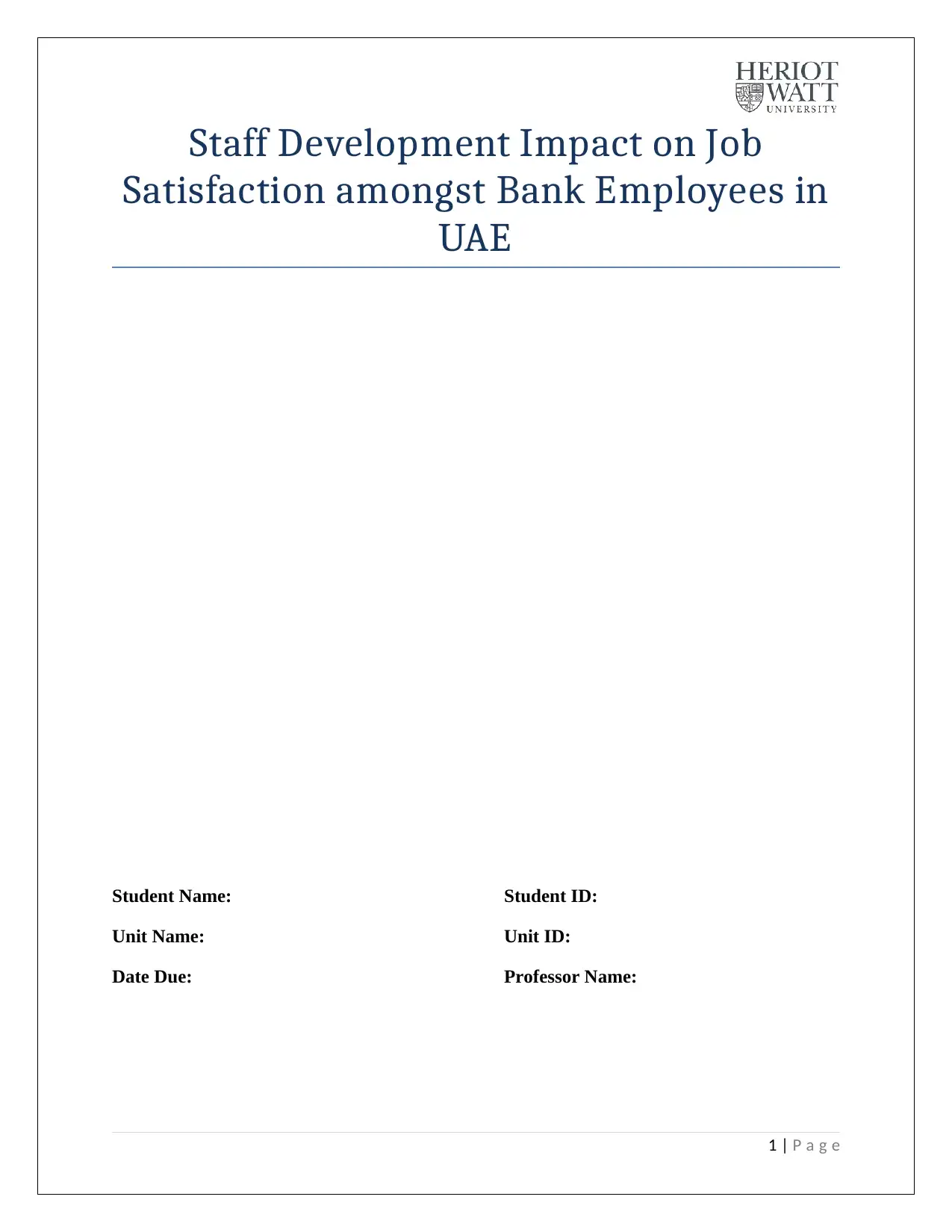
Staff Development Impact on Job
Satisfaction amongst Bank Employees in
UAE
Student Name: Student ID:
Unit Name: Unit ID:
Date Due: Professor Name:
1 | P a g e
Satisfaction amongst Bank Employees in
UAE
Student Name: Student ID:
Unit Name: Unit ID:
Date Due: Professor Name:
1 | P a g e
Secure Best Marks with AI Grader
Need help grading? Try our AI Grader for instant feedback on your assignments.
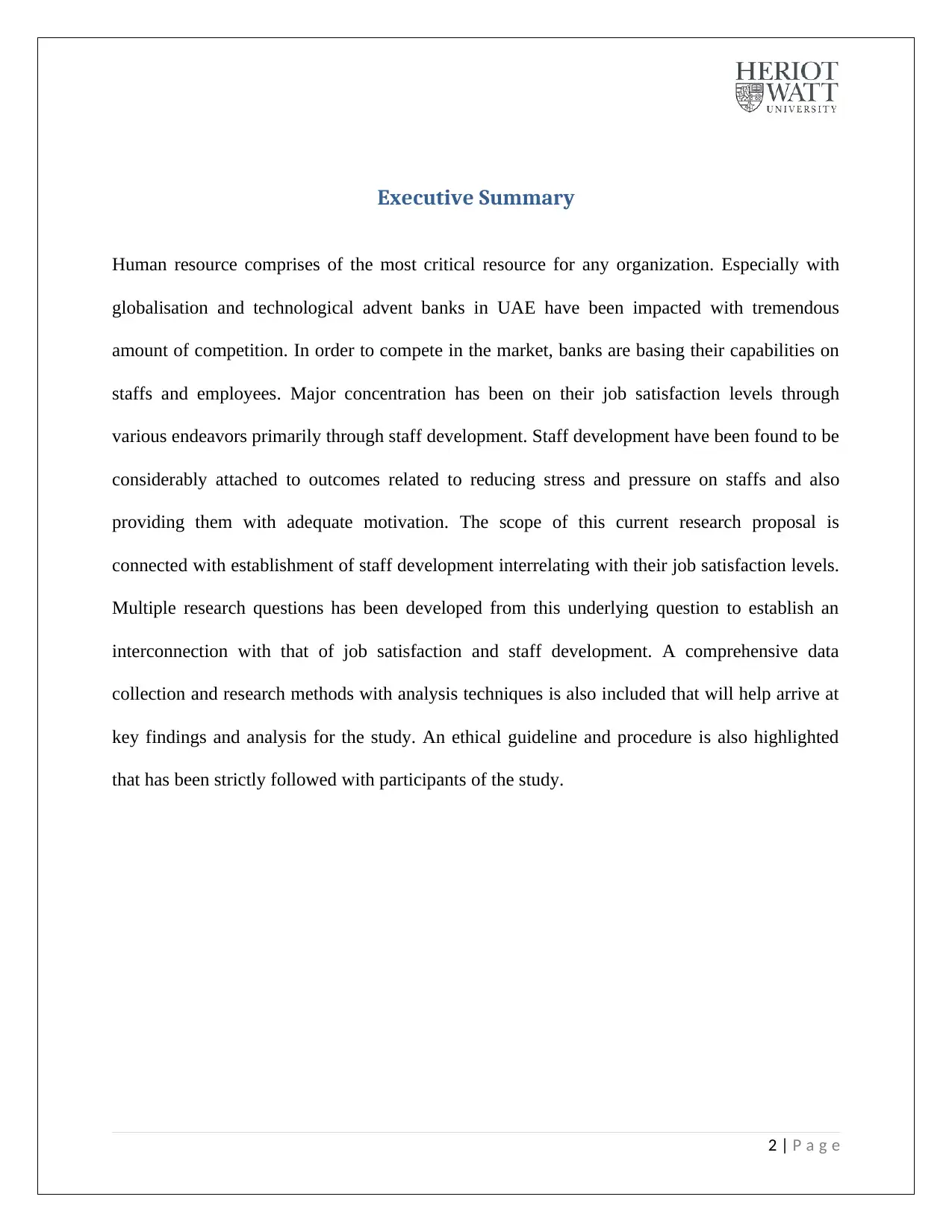
Executive Summary
Human resource comprises of the most critical resource for any organization. Especially with
globalisation and technological advent banks in UAE have been impacted with tremendous
amount of competition. In order to compete in the market, banks are basing their capabilities on
staffs and employees. Major concentration has been on their job satisfaction levels through
various endeavors primarily through staff development. Staff development have been found to be
considerably attached to outcomes related to reducing stress and pressure on staffs and also
providing them with adequate motivation. The scope of this current research proposal is
connected with establishment of staff development interrelating with their job satisfaction levels.
Multiple research questions has been developed from this underlying question to establish an
interconnection with that of job satisfaction and staff development. A comprehensive data
collection and research methods with analysis techniques is also included that will help arrive at
key findings and analysis for the study. An ethical guideline and procedure is also highlighted
that has been strictly followed with participants of the study.
2 | P a g e
Human resource comprises of the most critical resource for any organization. Especially with
globalisation and technological advent banks in UAE have been impacted with tremendous
amount of competition. In order to compete in the market, banks are basing their capabilities on
staffs and employees. Major concentration has been on their job satisfaction levels through
various endeavors primarily through staff development. Staff development have been found to be
considerably attached to outcomes related to reducing stress and pressure on staffs and also
providing them with adequate motivation. The scope of this current research proposal is
connected with establishment of staff development interrelating with their job satisfaction levels.
Multiple research questions has been developed from this underlying question to establish an
interconnection with that of job satisfaction and staff development. A comprehensive data
collection and research methods with analysis techniques is also included that will help arrive at
key findings and analysis for the study. An ethical guideline and procedure is also highlighted
that has been strictly followed with participants of the study.
2 | P a g e
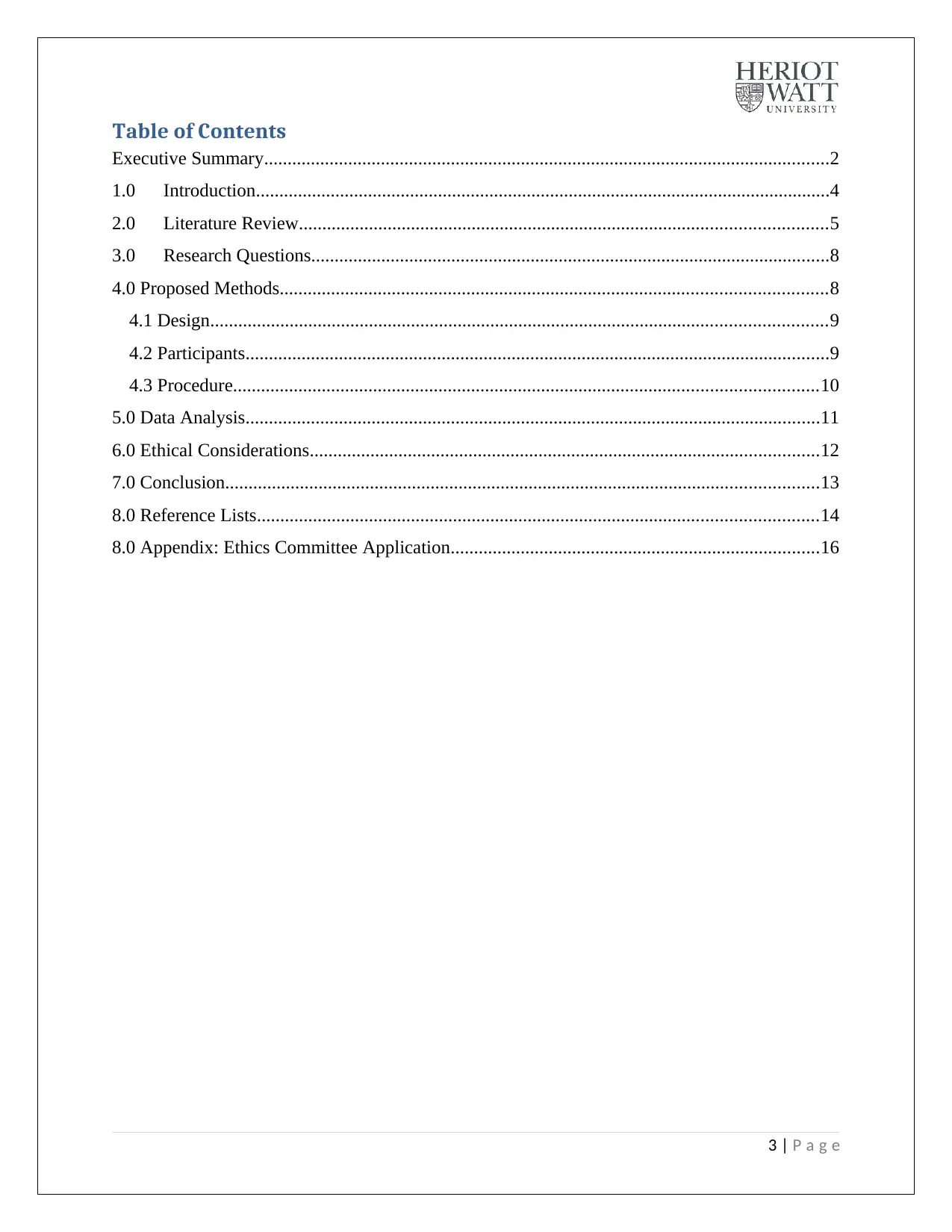
Table of Contents
Executive Summary.........................................................................................................................2
1.0 Introduction...........................................................................................................................4
2.0 Literature Review.................................................................................................................5
3.0 Research Questions...............................................................................................................8
4.0 Proposed Methods.....................................................................................................................8
4.1 Design....................................................................................................................................9
4.2 Participants.............................................................................................................................9
4.3 Procedure.............................................................................................................................10
5.0 Data Analysis...........................................................................................................................11
6.0 Ethical Considerations.............................................................................................................12
7.0 Conclusion...............................................................................................................................13
8.0 Reference Lists........................................................................................................................14
8.0 Appendix: Ethics Committee Application...............................................................................16
3 | P a g e
Executive Summary.........................................................................................................................2
1.0 Introduction...........................................................................................................................4
2.0 Literature Review.................................................................................................................5
3.0 Research Questions...............................................................................................................8
4.0 Proposed Methods.....................................................................................................................8
4.1 Design....................................................................................................................................9
4.2 Participants.............................................................................................................................9
4.3 Procedure.............................................................................................................................10
5.0 Data Analysis...........................................................................................................................11
6.0 Ethical Considerations.............................................................................................................12
7.0 Conclusion...............................................................................................................................13
8.0 Reference Lists........................................................................................................................14
8.0 Appendix: Ethics Committee Application...............................................................................16
3 | P a g e
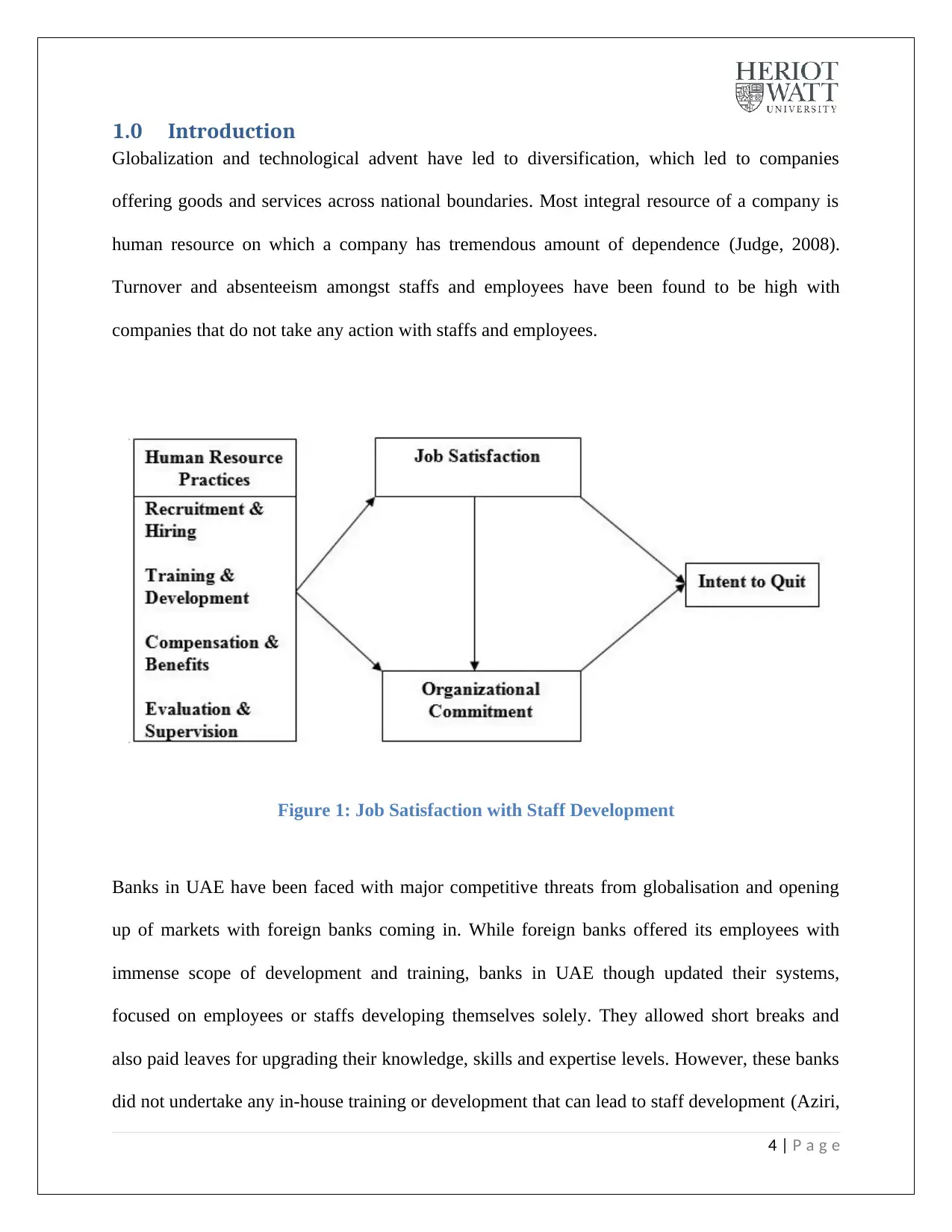
1.0 Introduction
Globalization and technological advent have led to diversification, which led to companies
offering goods and services across national boundaries. Most integral resource of a company is
human resource on which a company has tremendous amount of dependence (Judge, 2008).
Turnover and absenteeism amongst staffs and employees have been found to be high with
companies that do not take any action with staffs and employees.
Figure 1: Job Satisfaction with Staff Development
Banks in UAE have been faced with major competitive threats from globalisation and opening
up of markets with foreign banks coming in. While foreign banks offered its employees with
immense scope of development and training, banks in UAE though updated their systems,
focused on employees or staffs developing themselves solely. They allowed short breaks and
also paid leaves for upgrading their knowledge, skills and expertise levels. However, these banks
did not undertake any in-house training or development that can lead to staff development (Aziri,
4 | P a g e
Globalization and technological advent have led to diversification, which led to companies
offering goods and services across national boundaries. Most integral resource of a company is
human resource on which a company has tremendous amount of dependence (Judge, 2008).
Turnover and absenteeism amongst staffs and employees have been found to be high with
companies that do not take any action with staffs and employees.
Figure 1: Job Satisfaction with Staff Development
Banks in UAE have been faced with major competitive threats from globalisation and opening
up of markets with foreign banks coming in. While foreign banks offered its employees with
immense scope of development and training, banks in UAE though updated their systems,
focused on employees or staffs developing themselves solely. They allowed short breaks and
also paid leaves for upgrading their knowledge, skills and expertise levels. However, these banks
did not undertake any in-house training or development that can lead to staff development (Aziri,
4 | P a g e
Secure Best Marks with AI Grader
Need help grading? Try our AI Grader for instant feedback on your assignments.
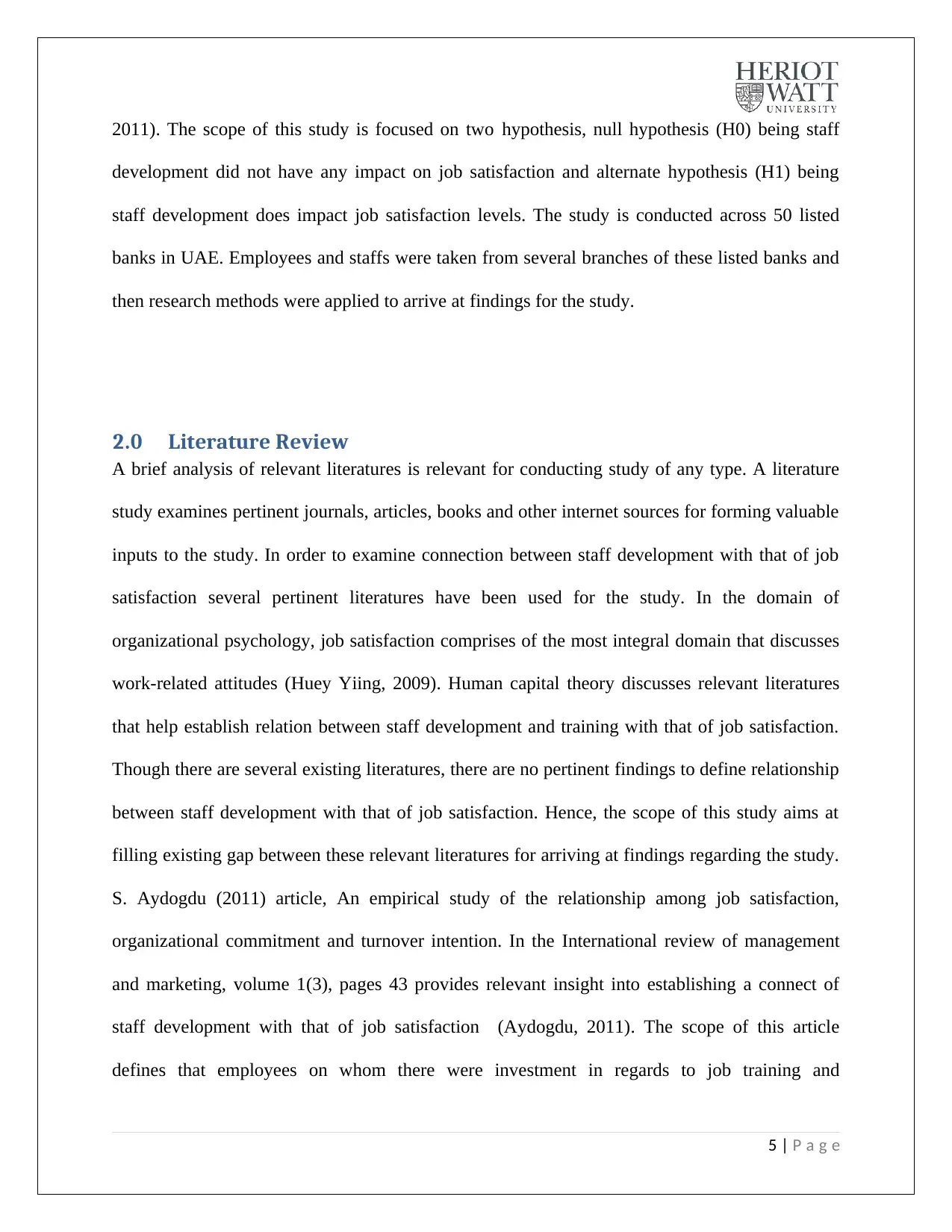
2011). The scope of this study is focused on two hypothesis, null hypothesis (H0) being staff
development did not have any impact on job satisfaction and alternate hypothesis (H1) being
staff development does impact job satisfaction levels. The study is conducted across 50 listed
banks in UAE. Employees and staffs were taken from several branches of these listed banks and
then research methods were applied to arrive at findings for the study.
2.0 Literature Review
A brief analysis of relevant literatures is relevant for conducting study of any type. A literature
study examines pertinent journals, articles, books and other internet sources for forming valuable
inputs to the study. In order to examine connection between staff development with that of job
satisfaction several pertinent literatures have been used for the study. In the domain of
organizational psychology, job satisfaction comprises of the most integral domain that discusses
work-related attitudes (Huey Yiing, 2009). Human capital theory discusses relevant literatures
that help establish relation between staff development and training with that of job satisfaction.
Though there are several existing literatures, there are no pertinent findings to define relationship
between staff development with that of job satisfaction. Hence, the scope of this study aims at
filling existing gap between these relevant literatures for arriving at findings regarding the study.
S. Aydogdu (2011) article, An empirical study of the relationship among job satisfaction,
organizational commitment and turnover intention. In the International review of management
and marketing, volume 1(3), pages 43 provides relevant insight into establishing a connect of
staff development with that of job satisfaction (Aydogdu, 2011). The scope of this article
defines that employees on whom there were investment in regards to job training and
5 | P a g e
development did not have any impact on job satisfaction and alternate hypothesis (H1) being
staff development does impact job satisfaction levels. The study is conducted across 50 listed
banks in UAE. Employees and staffs were taken from several branches of these listed banks and
then research methods were applied to arrive at findings for the study.
2.0 Literature Review
A brief analysis of relevant literatures is relevant for conducting study of any type. A literature
study examines pertinent journals, articles, books and other internet sources for forming valuable
inputs to the study. In order to examine connection between staff development with that of job
satisfaction several pertinent literatures have been used for the study. In the domain of
organizational psychology, job satisfaction comprises of the most integral domain that discusses
work-related attitudes (Huey Yiing, 2009). Human capital theory discusses relevant literatures
that help establish relation between staff development and training with that of job satisfaction.
Though there are several existing literatures, there are no pertinent findings to define relationship
between staff development with that of job satisfaction. Hence, the scope of this study aims at
filling existing gap between these relevant literatures for arriving at findings regarding the study.
S. Aydogdu (2011) article, An empirical study of the relationship among job satisfaction,
organizational commitment and turnover intention. In the International review of management
and marketing, volume 1(3), pages 43 provides relevant insight into establishing a connect of
staff development with that of job satisfaction (Aydogdu, 2011). The scope of this article
defines that employees on whom there were investment in regards to job training and
5 | P a g e
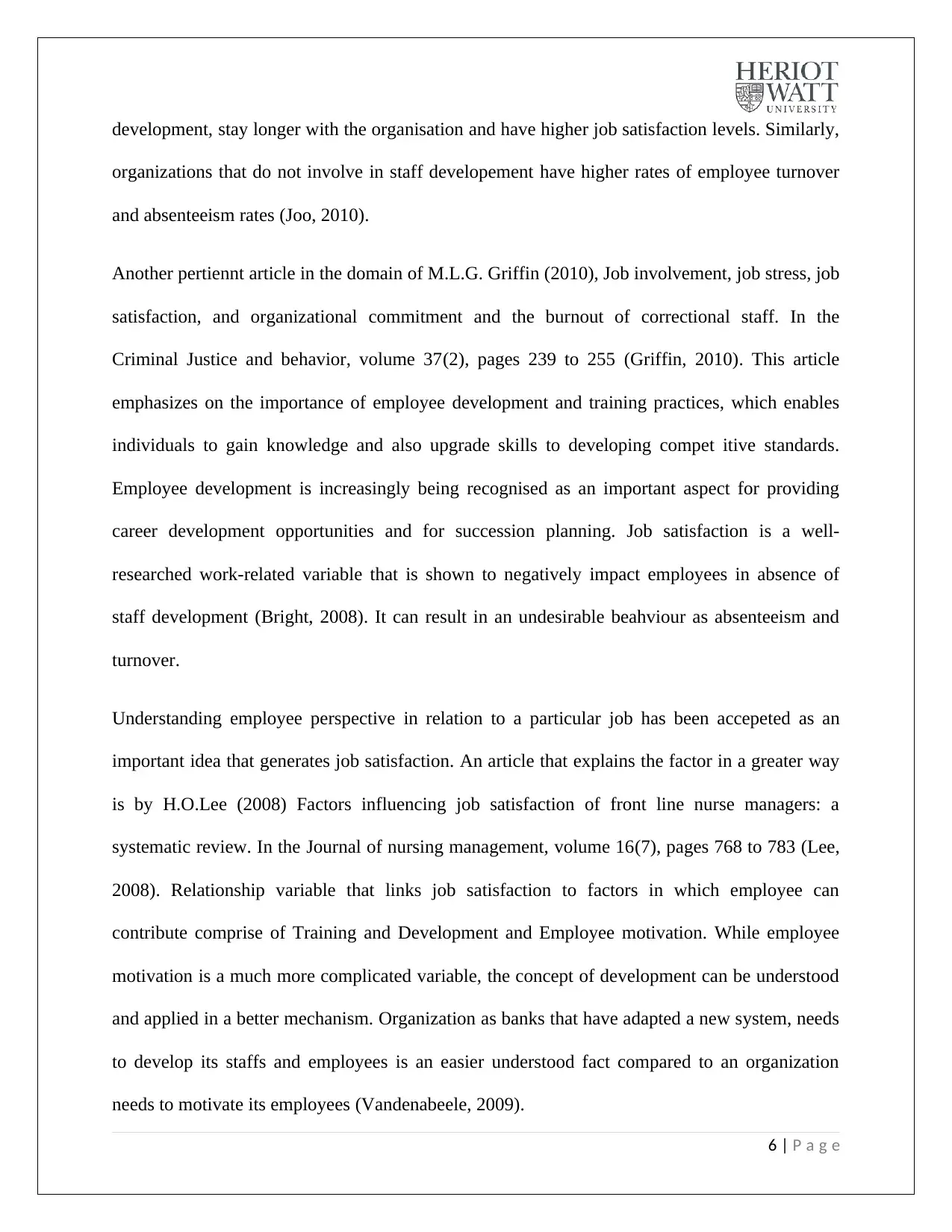
development, stay longer with the organisation and have higher job satisfaction levels. Similarly,
organizations that do not involve in staff developement have higher rates of employee turnover
and absenteeism rates (Joo, 2010).
Another pertiennt article in the domain of M.L.G. Griffin (2010), Job involvement, job stress, job
satisfaction, and organizational commitment and the burnout of correctional staff. In the
Criminal Justice and behavior, volume 37(2), pages 239 to 255 (Griffin, 2010). This article
emphasizes on the importance of employee development and training practices, which enables
individuals to gain knowledge and also upgrade skills to developing compet itive standards.
Employee development is increasingly being recognised as an important aspect for providing
career development opportunities and for succession planning. Job satisfaction is a well-
researched work-related variable that is shown to negatively impact employees in absence of
staff development (Bright, 2008). It can result in an undesirable beahviour as absenteeism and
turnover.
Understanding employee perspective in relation to a particular job has been accepeted as an
important idea that generates job satisfaction. An article that explains the factor in a greater way
is by H.O.Lee (2008) Factors influencing job satisfaction of front line nurse managers: a
systematic review. In the Journal of nursing management, volume 16(7), pages 768 to 783 (Lee,
2008). Relationship variable that links job satisfaction to factors in which employee can
contribute comprise of Training and Development and Employee motivation. While employee
motivation is a much more complicated variable, the concept of development can be understood
and applied in a better mechanism. Organization as banks that have adapted a new system, needs
to develop its staffs and employees is an easier understood fact compared to an organization
needs to motivate its employees (Vandenabeele, 2009).
6 | P a g e
organizations that do not involve in staff developement have higher rates of employee turnover
and absenteeism rates (Joo, 2010).
Another pertiennt article in the domain of M.L.G. Griffin (2010), Job involvement, job stress, job
satisfaction, and organizational commitment and the burnout of correctional staff. In the
Criminal Justice and behavior, volume 37(2), pages 239 to 255 (Griffin, 2010). This article
emphasizes on the importance of employee development and training practices, which enables
individuals to gain knowledge and also upgrade skills to developing compet itive standards.
Employee development is increasingly being recognised as an important aspect for providing
career development opportunities and for succession planning. Job satisfaction is a well-
researched work-related variable that is shown to negatively impact employees in absence of
staff development (Bright, 2008). It can result in an undesirable beahviour as absenteeism and
turnover.
Understanding employee perspective in relation to a particular job has been accepeted as an
important idea that generates job satisfaction. An article that explains the factor in a greater way
is by H.O.Lee (2008) Factors influencing job satisfaction of front line nurse managers: a
systematic review. In the Journal of nursing management, volume 16(7), pages 768 to 783 (Lee,
2008). Relationship variable that links job satisfaction to factors in which employee can
contribute comprise of Training and Development and Employee motivation. While employee
motivation is a much more complicated variable, the concept of development can be understood
and applied in a better mechanism. Organization as banks that have adapted a new system, needs
to develop its staffs and employees is an easier understood fact compared to an organization
needs to motivate its employees (Vandenabeele, 2009).
6 | P a g e
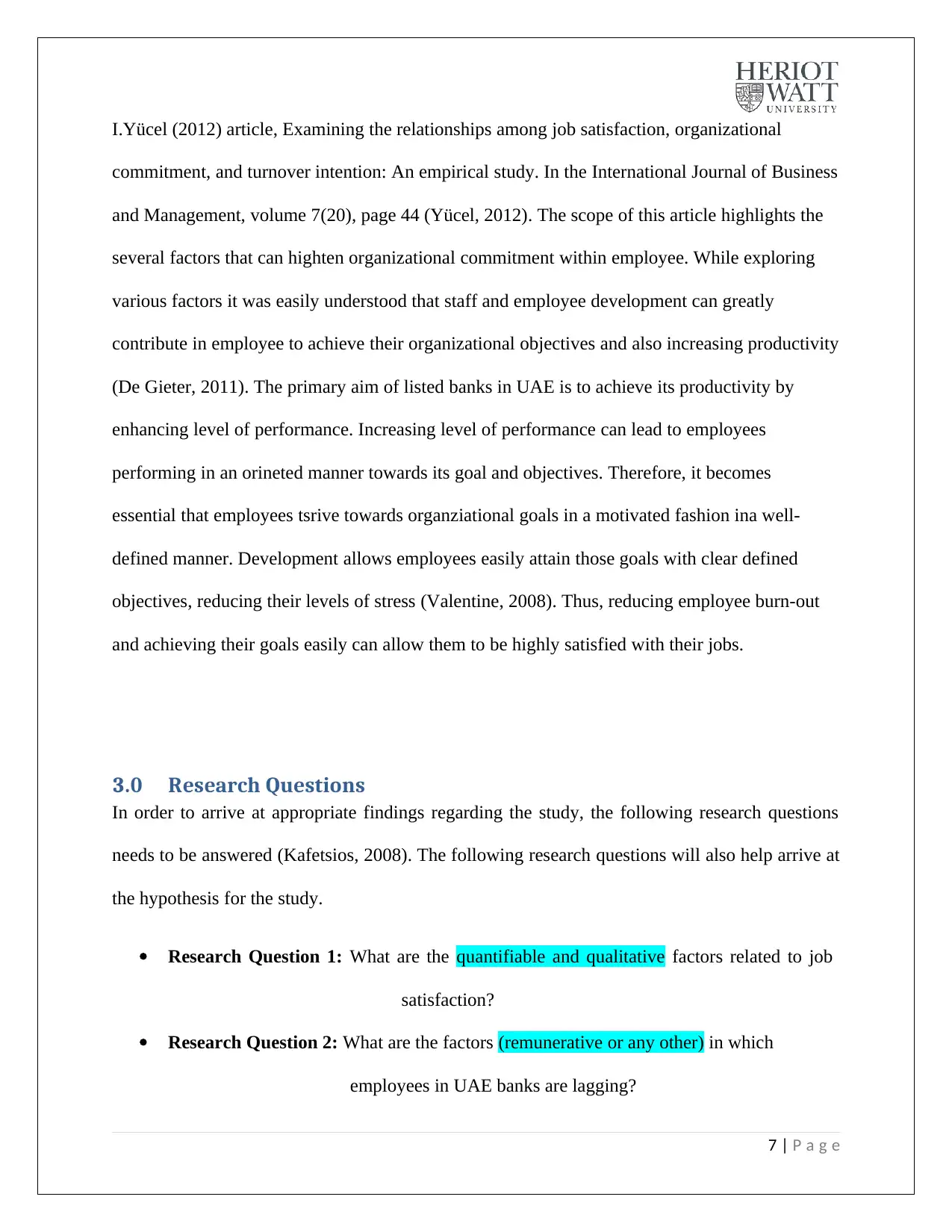
I.Yücel (2012) article, Examining the relationships among job satisfaction, organizational
commitment, and turnover intention: An empirical study. In the International Journal of Business
and Management, volume 7(20), page 44 (Yücel, 2012). The scope of this article highlights the
several factors that can highten organizational commitment within employee. While exploring
various factors it was easily understood that staff and employee development can greatly
contribute in employee to achieve their organizational objectives and also increasing productivity
(De Gieter, 2011). The primary aim of listed banks in UAE is to achieve its productivity by
enhancing level of performance. Increasing level of performance can lead to employees
performing in an orineted manner towards its goal and objectives. Therefore, it becomes
essential that employees tsrive towards organziational goals in a motivated fashion ina well-
defined manner. Development allows employees easily attain those goals with clear defined
objectives, reducing their levels of stress (Valentine, 2008). Thus, reducing employee burn-out
and achieving their goals easily can allow them to be highly satisfied with their jobs.
3.0 Research Questions
In order to arrive at appropriate findings regarding the study, the following research questions
needs to be answered (Kafetsios, 2008). The following research questions will also help arrive at
the hypothesis for the study.
Research Question 1: What are the quantifiable and qualitative factors related to job
satisfaction?
Research Question 2: What are the factors (remunerative or any other) in which
employees in UAE banks are lagging?
7 | P a g e
commitment, and turnover intention: An empirical study. In the International Journal of Business
and Management, volume 7(20), page 44 (Yücel, 2012). The scope of this article highlights the
several factors that can highten organizational commitment within employee. While exploring
various factors it was easily understood that staff and employee development can greatly
contribute in employee to achieve their organizational objectives and also increasing productivity
(De Gieter, 2011). The primary aim of listed banks in UAE is to achieve its productivity by
enhancing level of performance. Increasing level of performance can lead to employees
performing in an orineted manner towards its goal and objectives. Therefore, it becomes
essential that employees tsrive towards organziational goals in a motivated fashion ina well-
defined manner. Development allows employees easily attain those goals with clear defined
objectives, reducing their levels of stress (Valentine, 2008). Thus, reducing employee burn-out
and achieving their goals easily can allow them to be highly satisfied with their jobs.
3.0 Research Questions
In order to arrive at appropriate findings regarding the study, the following research questions
needs to be answered (Kafetsios, 2008). The following research questions will also help arrive at
the hypothesis for the study.
Research Question 1: What are the quantifiable and qualitative factors related to job
satisfaction?
Research Question 2: What are the factors (remunerative or any other) in which
employees in UAE banks are lagging?
7 | P a g e
Paraphrase This Document
Need a fresh take? Get an instant paraphrase of this document with our AI Paraphraser
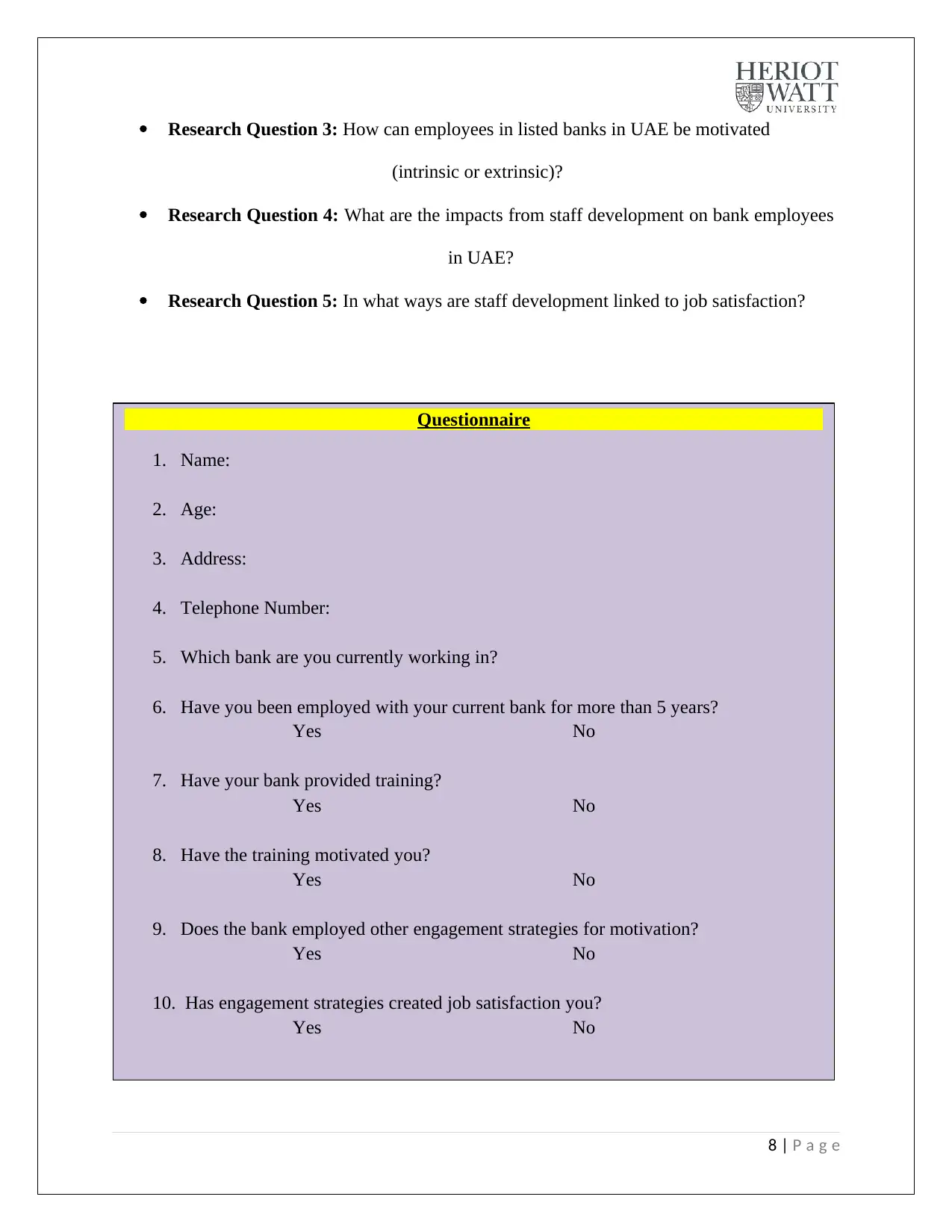
Research Question 3: How can employees in listed banks in UAE be motivated
(intrinsic or extrinsic)?
Research Question 4: What are the impacts from staff development on bank employees
in UAE?
Research Question 5: In what ways are staff development linked to job satisfaction?
8 | P a g e
Questionnaire
1. Name:
2. Age:
3. Address:
4. Telephone Number:
5. Which bank are you currently working in?
6. Have you been employed with your current bank for more than 5 years?
Yes No
7. Have your bank provided training?
Yes No
8. Have the training motivated you?
Yes No
9. Does the bank employed other engagement strategies for motivation?
Yes No
10. Has engagement strategies created job satisfaction you?
Yes No
(intrinsic or extrinsic)?
Research Question 4: What are the impacts from staff development on bank employees
in UAE?
Research Question 5: In what ways are staff development linked to job satisfaction?
8 | P a g e
Questionnaire
1. Name:
2. Age:
3. Address:
4. Telephone Number:
5. Which bank are you currently working in?
6. Have you been employed with your current bank for more than 5 years?
Yes No
7. Have your bank provided training?
Yes No
8. Have the training motivated you?
Yes No
9. Does the bank employed other engagement strategies for motivation?
Yes No
10. Has engagement strategies created job satisfaction you?
Yes No
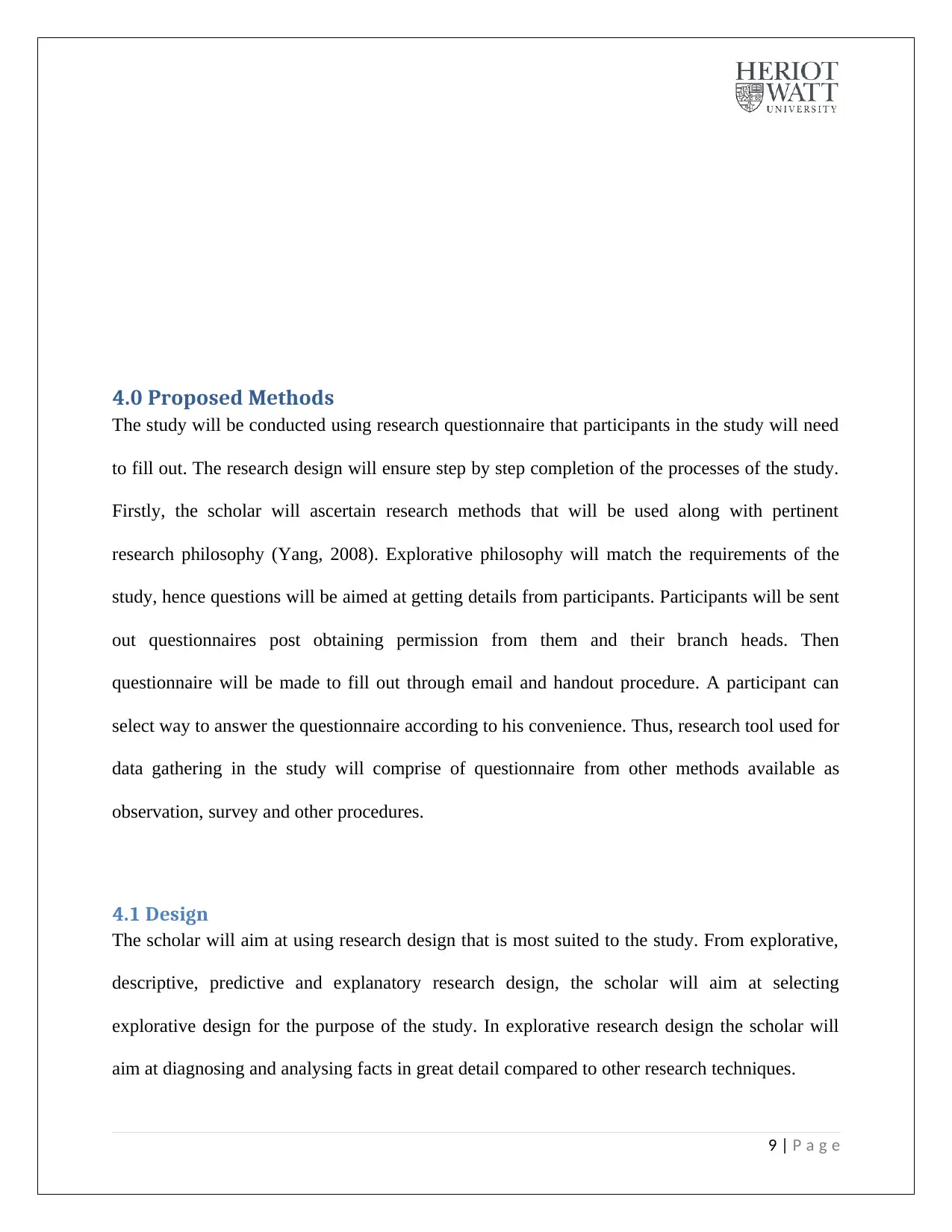
4.0 Proposed Methods
The study will be conducted using research questionnaire that participants in the study will need
to fill out. The research design will ensure step by step completion of the processes of the study.
Firstly, the scholar will ascertain research methods that will be used along with pertinent
research philosophy (Yang, 2008). Explorative philosophy will match the requirements of the
study, hence questions will be aimed at getting details from participants. Participants will be sent
out questionnaires post obtaining permission from them and their branch heads. Then
questionnaire will be made to fill out through email and handout procedure. A participant can
select way to answer the questionnaire according to his convenience. Thus, research tool used for
data gathering in the study will comprise of questionnaire from other methods available as
observation, survey and other procedures.
4.1 Design
The scholar will aim at using research design that is most suited to the study. From explorative,
descriptive, predictive and explanatory research design, the scholar will aim at selecting
explorative design for the purpose of the study. In explorative research design the scholar will
aim at diagnosing and analysing facts in great detail compared to other research techniques.
9 | P a g e
The study will be conducted using research questionnaire that participants in the study will need
to fill out. The research design will ensure step by step completion of the processes of the study.
Firstly, the scholar will ascertain research methods that will be used along with pertinent
research philosophy (Yang, 2008). Explorative philosophy will match the requirements of the
study, hence questions will be aimed at getting details from participants. Participants will be sent
out questionnaires post obtaining permission from them and their branch heads. Then
questionnaire will be made to fill out through email and handout procedure. A participant can
select way to answer the questionnaire according to his convenience. Thus, research tool used for
data gathering in the study will comprise of questionnaire from other methods available as
observation, survey and other procedures.
4.1 Design
The scholar will aim at using research design that is most suited to the study. From explorative,
descriptive, predictive and explanatory research design, the scholar will aim at selecting
explorative design for the purpose of the study. In explorative research design the scholar will
aim at diagnosing and analysing facts in great detail compared to other research techniques.
9 | P a g e
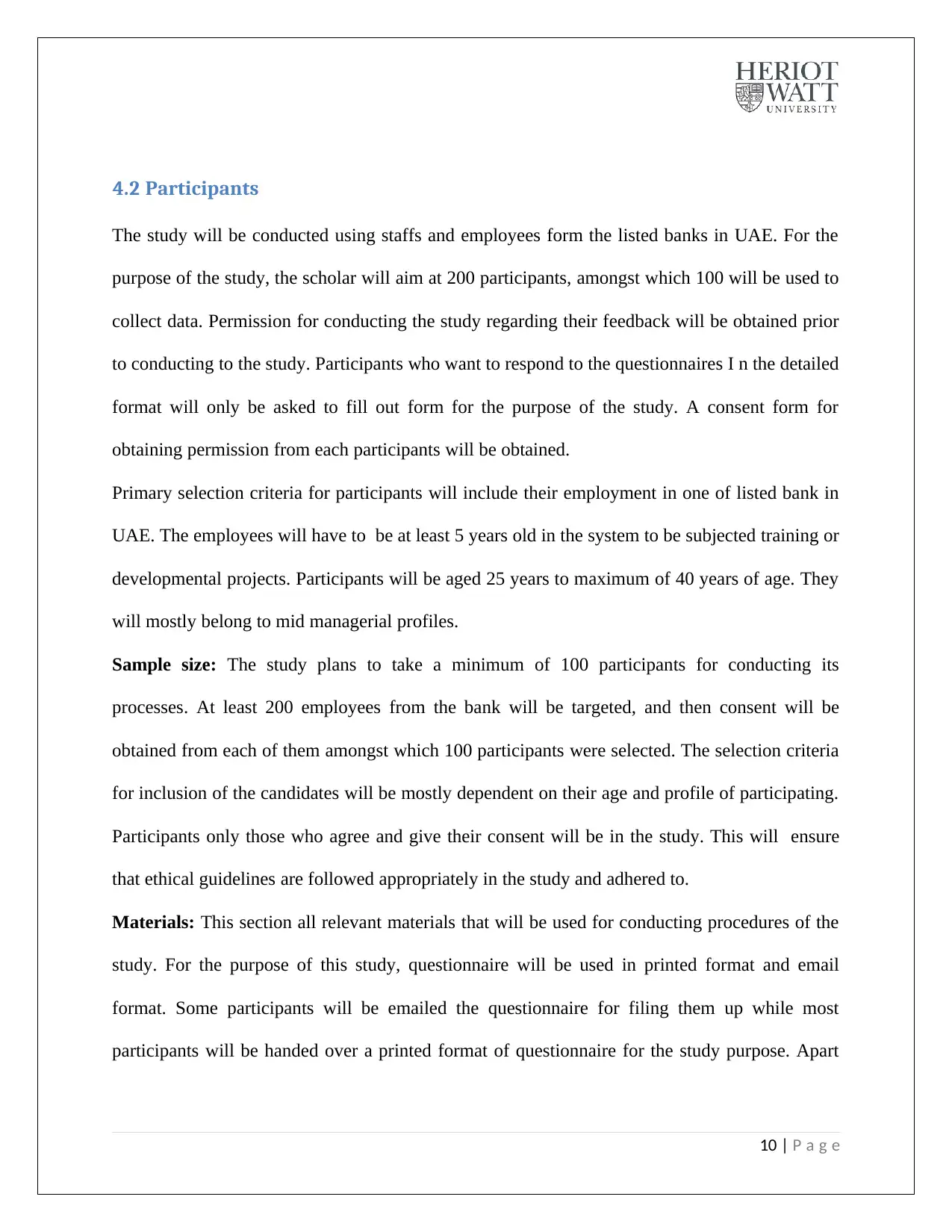
4.2 Participants
The study will be conducted using staffs and employees form the listed banks in UAE. For the
purpose of the study, the scholar will aim at 200 participants, amongst which 100 will be used to
collect data. Permission for conducting the study regarding their feedback will be obtained prior
to conducting to the study. Participants who want to respond to the questionnaires I n the detailed
format will only be asked to fill out form for the purpose of the study. A consent form for
obtaining permission from each participants will be obtained.
Primary selection criteria for participants will include their employment in one of listed bank in
UAE. The employees will have to be at least 5 years old in the system to be subjected training or
developmental projects. Participants will be aged 25 years to maximum of 40 years of age. They
will mostly belong to mid managerial profiles.
Sample size: The study plans to take a minimum of 100 participants for conducting its
processes. At least 200 employees from the bank will be targeted, and then consent will be
obtained from each of them amongst which 100 participants were selected. The selection criteria
for inclusion of the candidates will be mostly dependent on their age and profile of participating.
Participants only those who agree and give their consent will be in the study. This will ensure
that ethical guidelines are followed appropriately in the study and adhered to.
Materials: This section all relevant materials that will be used for conducting procedures of the
study. For the purpose of this study, questionnaire will be used in printed format and email
format. Some participants will be emailed the questionnaire for filing them up while most
participants will be handed over a printed format of questionnaire for the study purpose. Apart
10 | P a g e
The study will be conducted using staffs and employees form the listed banks in UAE. For the
purpose of the study, the scholar will aim at 200 participants, amongst which 100 will be used to
collect data. Permission for conducting the study regarding their feedback will be obtained prior
to conducting to the study. Participants who want to respond to the questionnaires I n the detailed
format will only be asked to fill out form for the purpose of the study. A consent form for
obtaining permission from each participants will be obtained.
Primary selection criteria for participants will include their employment in one of listed bank in
UAE. The employees will have to be at least 5 years old in the system to be subjected training or
developmental projects. Participants will be aged 25 years to maximum of 40 years of age. They
will mostly belong to mid managerial profiles.
Sample size: The study plans to take a minimum of 100 participants for conducting its
processes. At least 200 employees from the bank will be targeted, and then consent will be
obtained from each of them amongst which 100 participants were selected. The selection criteria
for inclusion of the candidates will be mostly dependent on their age and profile of participating.
Participants only those who agree and give their consent will be in the study. This will ensure
that ethical guidelines are followed appropriately in the study and adhered to.
Materials: This section all relevant materials that will be used for conducting procedures of the
study. For the purpose of this study, questionnaire will be used in printed format and email
format. Some participants will be emailed the questionnaire for filing them up while most
participants will be handed over a printed format of questionnaire for the study purpose. Apart
10 | P a g e
Secure Best Marks with AI Grader
Need help grading? Try our AI Grader for instant feedback on your assignments.
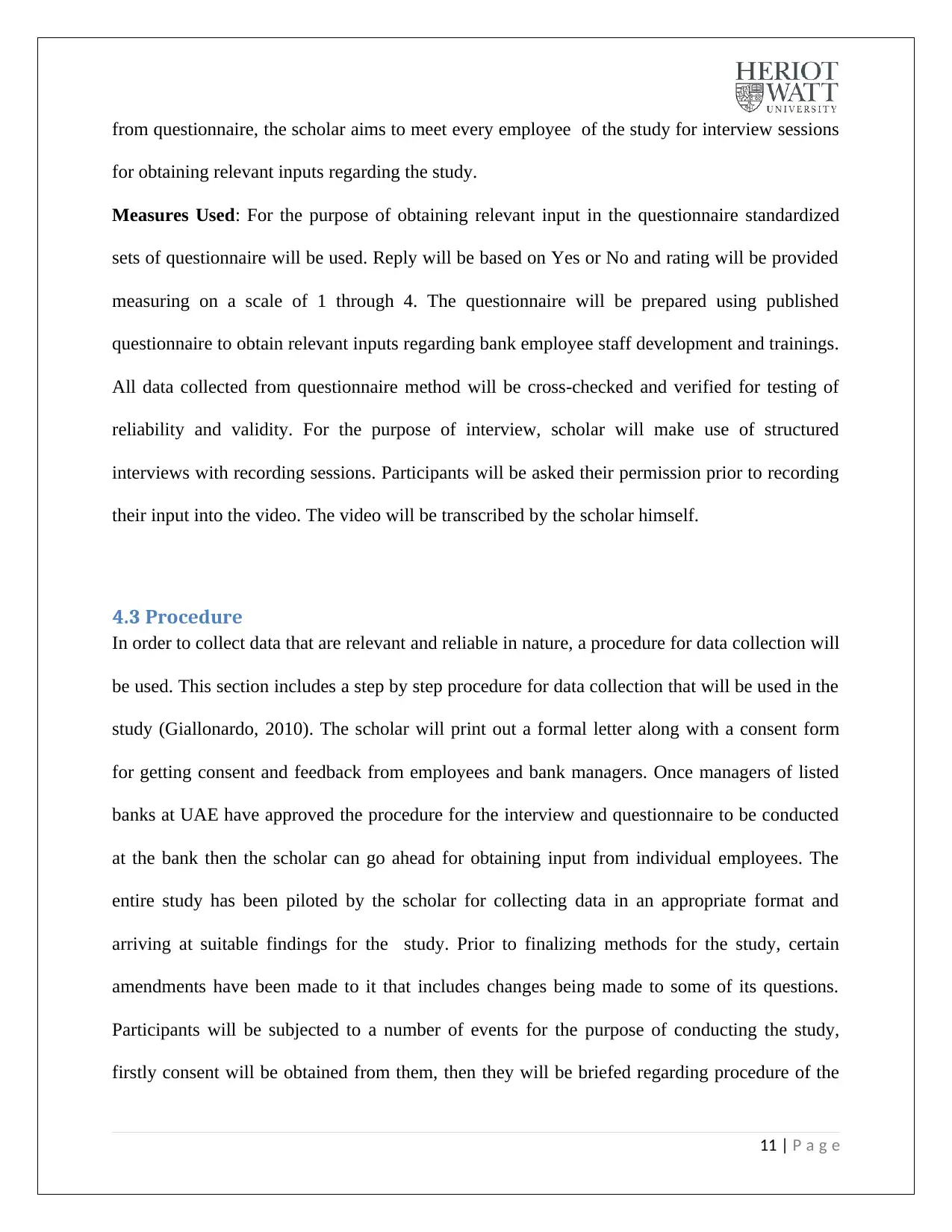
from questionnaire, the scholar aims to meet every employee of the study for interview sessions
for obtaining relevant inputs regarding the study.
Measures Used: For the purpose of obtaining relevant input in the questionnaire standardized
sets of questionnaire will be used. Reply will be based on Yes or No and rating will be provided
measuring on a scale of 1 through 4. The questionnaire will be prepared using published
questionnaire to obtain relevant inputs regarding bank employee staff development and trainings.
All data collected from questionnaire method will be cross-checked and verified for testing of
reliability and validity. For the purpose of interview, scholar will make use of structured
interviews with recording sessions. Participants will be asked their permission prior to recording
their input into the video. The video will be transcribed by the scholar himself.
4.3 Procedure
In order to collect data that are relevant and reliable in nature, a procedure for data collection will
be used. This section includes a step by step procedure for data collection that will be used in the
study (Giallonardo, 2010). The scholar will print out a formal letter along with a consent form
for getting consent and feedback from employees and bank managers. Once managers of listed
banks at UAE have approved the procedure for the interview and questionnaire to be conducted
at the bank then the scholar can go ahead for obtaining input from individual employees. The
entire study has been piloted by the scholar for collecting data in an appropriate format and
arriving at suitable findings for the study. Prior to finalizing methods for the study, certain
amendments have been made to it that includes changes being made to some of its questions.
Participants will be subjected to a number of events for the purpose of conducting the study,
firstly consent will be obtained from them, then they will be briefed regarding procedure of the
11 | P a g e
for obtaining relevant inputs regarding the study.
Measures Used: For the purpose of obtaining relevant input in the questionnaire standardized
sets of questionnaire will be used. Reply will be based on Yes or No and rating will be provided
measuring on a scale of 1 through 4. The questionnaire will be prepared using published
questionnaire to obtain relevant inputs regarding bank employee staff development and trainings.
All data collected from questionnaire method will be cross-checked and verified for testing of
reliability and validity. For the purpose of interview, scholar will make use of structured
interviews with recording sessions. Participants will be asked their permission prior to recording
their input into the video. The video will be transcribed by the scholar himself.
4.3 Procedure
In order to collect data that are relevant and reliable in nature, a procedure for data collection will
be used. This section includes a step by step procedure for data collection that will be used in the
study (Giallonardo, 2010). The scholar will print out a formal letter along with a consent form
for getting consent and feedback from employees and bank managers. Once managers of listed
banks at UAE have approved the procedure for the interview and questionnaire to be conducted
at the bank then the scholar can go ahead for obtaining input from individual employees. The
entire study has been piloted by the scholar for collecting data in an appropriate format and
arriving at suitable findings for the study. Prior to finalizing methods for the study, certain
amendments have been made to it that includes changes being made to some of its questions.
Participants will be subjected to a number of events for the purpose of conducting the study,
firstly consent will be obtained from them, then they will be briefed regarding procedure of the
11 | P a g e
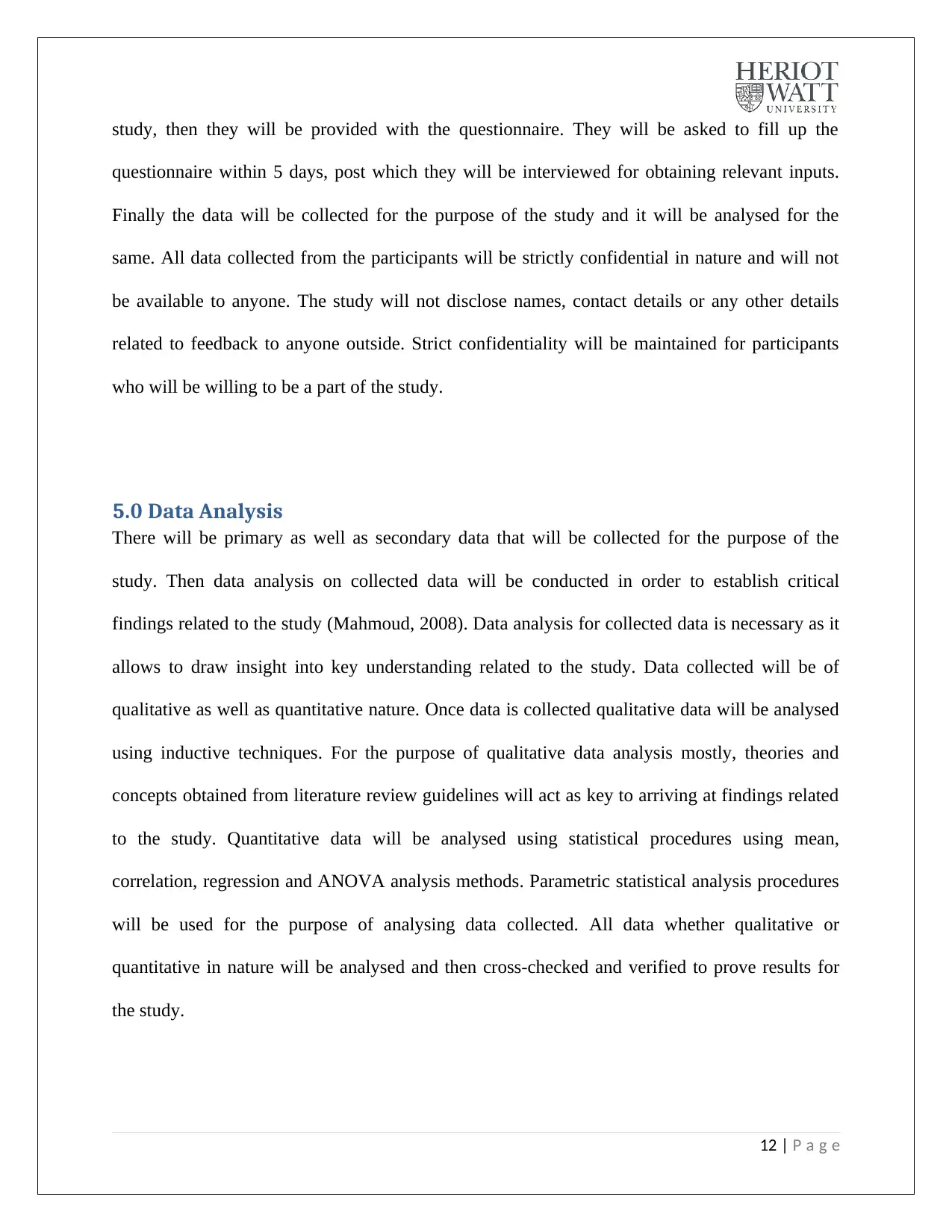
study, then they will be provided with the questionnaire. They will be asked to fill up the
questionnaire within 5 days, post which they will be interviewed for obtaining relevant inputs.
Finally the data will be collected for the purpose of the study and it will be analysed for the
same. All data collected from the participants will be strictly confidential in nature and will not
be available to anyone. The study will not disclose names, contact details or any other details
related to feedback to anyone outside. Strict confidentiality will be maintained for participants
who will be willing to be a part of the study.
5.0 Data Analysis
There will be primary as well as secondary data that will be collected for the purpose of the
study. Then data analysis on collected data will be conducted in order to establish critical
findings related to the study (Mahmoud, 2008). Data analysis for collected data is necessary as it
allows to draw insight into key understanding related to the study. Data collected will be of
qualitative as well as quantitative nature. Once data is collected qualitative data will be analysed
using inductive techniques. For the purpose of qualitative data analysis mostly, theories and
concepts obtained from literature review guidelines will act as key to arriving at findings related
to the study. Quantitative data will be analysed using statistical procedures using mean,
correlation, regression and ANOVA analysis methods. Parametric statistical analysis procedures
will be used for the purpose of analysing data collected. All data whether qualitative or
quantitative in nature will be analysed and then cross-checked and verified to prove results for
the study.
12 | P a g e
questionnaire within 5 days, post which they will be interviewed for obtaining relevant inputs.
Finally the data will be collected for the purpose of the study and it will be analysed for the
same. All data collected from the participants will be strictly confidential in nature and will not
be available to anyone. The study will not disclose names, contact details or any other details
related to feedback to anyone outside. Strict confidentiality will be maintained for participants
who will be willing to be a part of the study.
5.0 Data Analysis
There will be primary as well as secondary data that will be collected for the purpose of the
study. Then data analysis on collected data will be conducted in order to establish critical
findings related to the study (Mahmoud, 2008). Data analysis for collected data is necessary as it
allows to draw insight into key understanding related to the study. Data collected will be of
qualitative as well as quantitative nature. Once data is collected qualitative data will be analysed
using inductive techniques. For the purpose of qualitative data analysis mostly, theories and
concepts obtained from literature review guidelines will act as key to arriving at findings related
to the study. Quantitative data will be analysed using statistical procedures using mean,
correlation, regression and ANOVA analysis methods. Parametric statistical analysis procedures
will be used for the purpose of analysing data collected. All data whether qualitative or
quantitative in nature will be analysed and then cross-checked and verified to prove results for
the study.
12 | P a g e
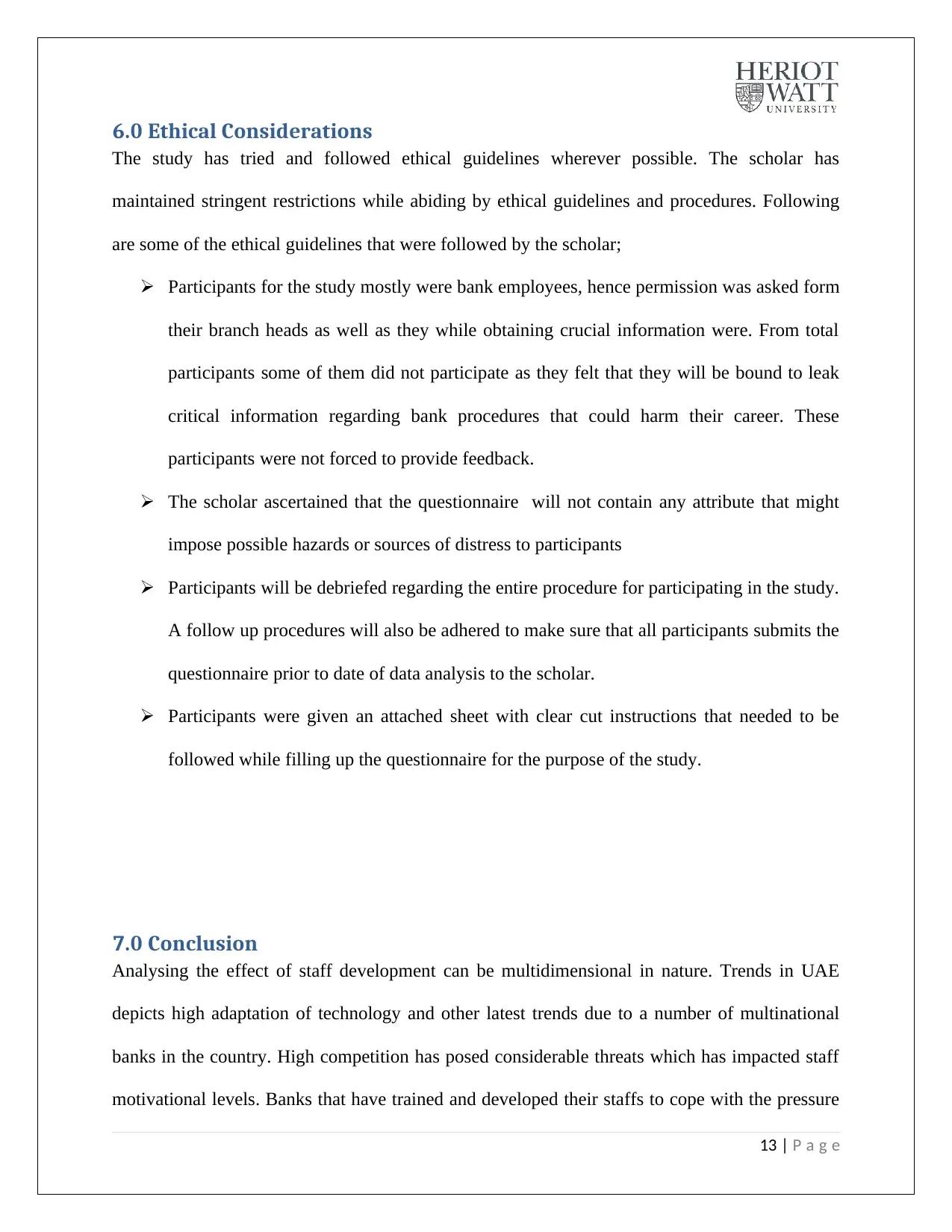
6.0 Ethical Considerations
The study has tried and followed ethical guidelines wherever possible. The scholar has
maintained stringent restrictions while abiding by ethical guidelines and procedures. Following
are some of the ethical guidelines that were followed by the scholar;
Participants for the study mostly were bank employees, hence permission was asked form
their branch heads as well as they while obtaining crucial information were. From total
participants some of them did not participate as they felt that they will be bound to leak
critical information regarding bank procedures that could harm their career. These
participants were not forced to provide feedback.
The scholar ascertained that the questionnaire will not contain any attribute that might
impose possible hazards or sources of distress to participants
Participants will be debriefed regarding the entire procedure for participating in the study.
A follow up procedures will also be adhered to make sure that all participants submits the
questionnaire prior to date of data analysis to the scholar.
Participants were given an attached sheet with clear cut instructions that needed to be
followed while filling up the questionnaire for the purpose of the study.
7.0 Conclusion
Analysing the effect of staff development can be multidimensional in nature. Trends in UAE
depicts high adaptation of technology and other latest trends due to a number of multinational
banks in the country. High competition has posed considerable threats which has impacted staff
motivational levels. Banks that have trained and developed their staffs to cope with the pressure
13 | P a g e
The study has tried and followed ethical guidelines wherever possible. The scholar has
maintained stringent restrictions while abiding by ethical guidelines and procedures. Following
are some of the ethical guidelines that were followed by the scholar;
Participants for the study mostly were bank employees, hence permission was asked form
their branch heads as well as they while obtaining crucial information were. From total
participants some of them did not participate as they felt that they will be bound to leak
critical information regarding bank procedures that could harm their career. These
participants were not forced to provide feedback.
The scholar ascertained that the questionnaire will not contain any attribute that might
impose possible hazards or sources of distress to participants
Participants will be debriefed regarding the entire procedure for participating in the study.
A follow up procedures will also be adhered to make sure that all participants submits the
questionnaire prior to date of data analysis to the scholar.
Participants were given an attached sheet with clear cut instructions that needed to be
followed while filling up the questionnaire for the purpose of the study.
7.0 Conclusion
Analysing the effect of staff development can be multidimensional in nature. Trends in UAE
depicts high adaptation of technology and other latest trends due to a number of multinational
banks in the country. High competition has posed considerable threats which has impacted staff
motivational levels. Banks that have trained and developed their staffs to cope with the pressure
13 | P a g e
Paraphrase This Document
Need a fresh take? Get an instant paraphrase of this document with our AI Paraphraser
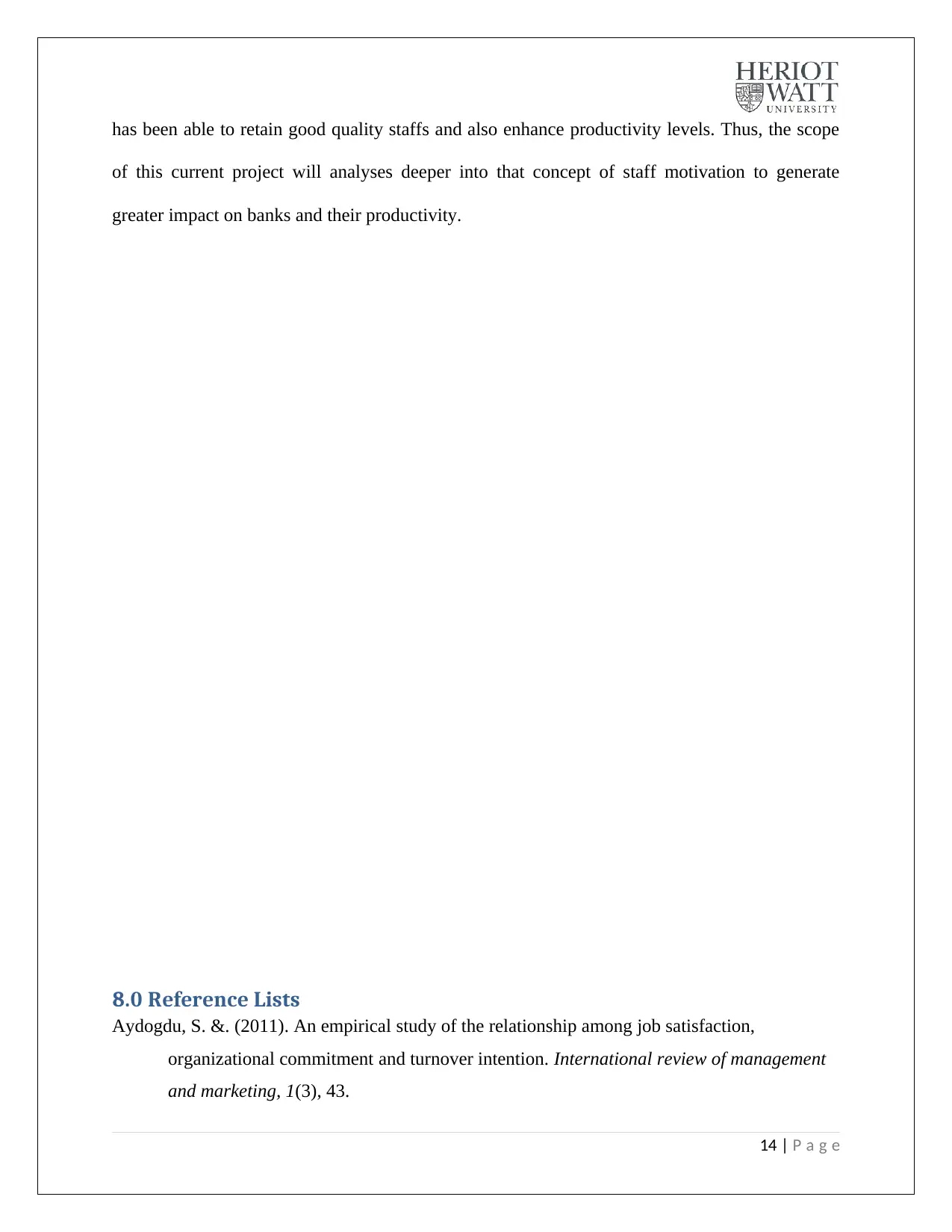
has been able to retain good quality staffs and also enhance productivity levels. Thus, the scope
of this current project will analyses deeper into that concept of staff motivation to generate
greater impact on banks and their productivity.
8.0 Reference Lists
Aydogdu, S. &. (2011). An empirical study of the relationship among job satisfaction,
organizational commitment and turnover intention. International review of management
and marketing, 1(3), 43.
14 | P a g e
of this current project will analyses deeper into that concept of staff motivation to generate
greater impact on banks and their productivity.
8.0 Reference Lists
Aydogdu, S. &. (2011). An empirical study of the relationship among job satisfaction,
organizational commitment and turnover intention. International review of management
and marketing, 1(3), 43.
14 | P a g e
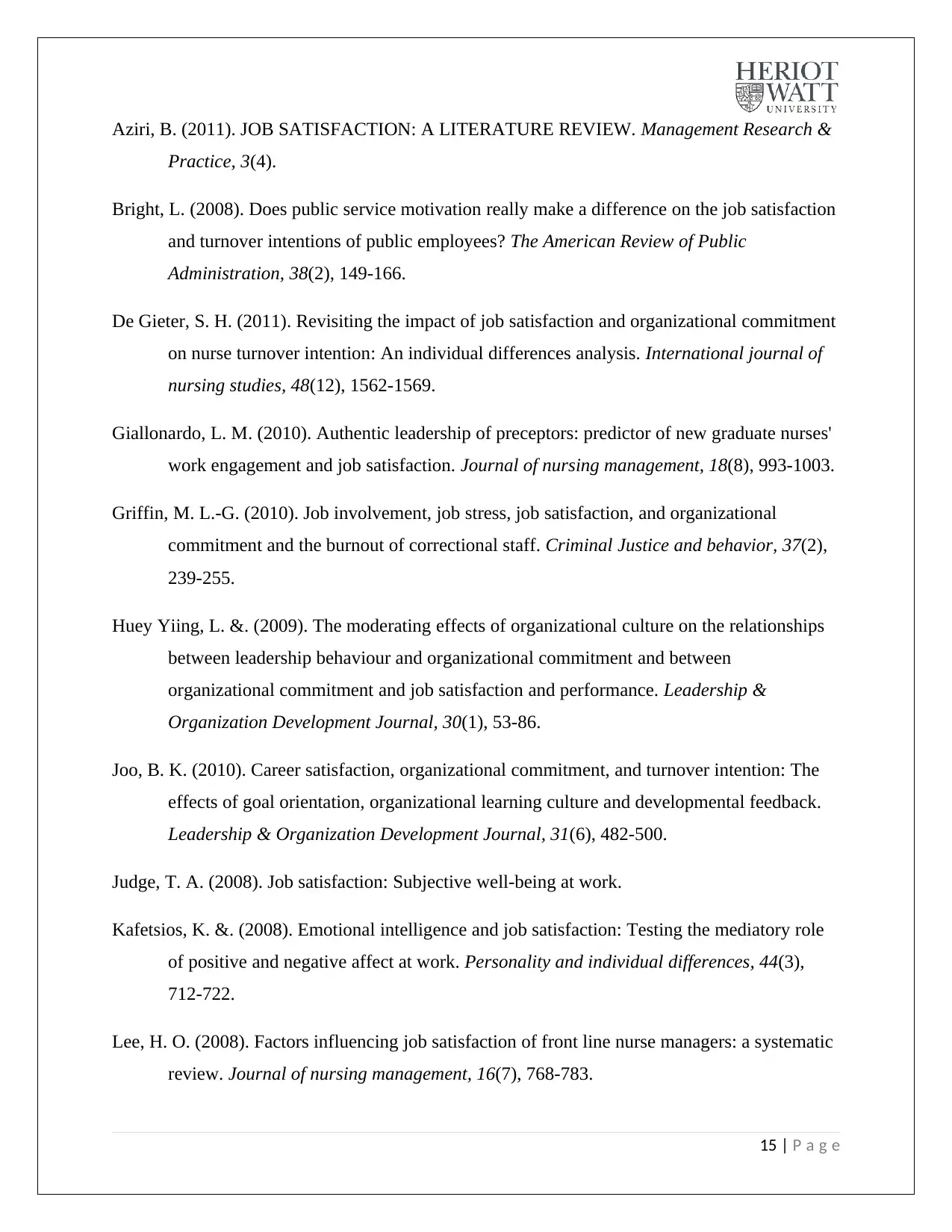
Aziri, B. (2011). JOB SATISFACTION: A LITERATURE REVIEW. Management Research &
Practice, 3(4).
Bright, L. (2008). Does public service motivation really make a difference on the job satisfaction
and turnover intentions of public employees? The American Review of Public
Administration, 38(2), 149-166.
De Gieter, S. H. (2011). Revisiting the impact of job satisfaction and organizational commitment
on nurse turnover intention: An individual differences analysis. International journal of
nursing studies, 48(12), 1562-1569.
Giallonardo, L. M. (2010). Authentic leadership of preceptors: predictor of new graduate nurses'
work engagement and job satisfaction. Journal of nursing management, 18(8), 993-1003.
Griffin, M. L.-G. (2010). Job involvement, job stress, job satisfaction, and organizational
commitment and the burnout of correctional staff. Criminal Justice and behavior, 37(2),
239-255.
Huey Yiing, L. &. (2009). The moderating effects of organizational culture on the relationships
between leadership behaviour and organizational commitment and between
organizational commitment and job satisfaction and performance. Leadership &
Organization Development Journal, 30(1), 53-86.
Joo, B. K. (2010). Career satisfaction, organizational commitment, and turnover intention: The
effects of goal orientation, organizational learning culture and developmental feedback.
Leadership & Organization Development Journal, 31(6), 482-500.
Judge, T. A. (2008). Job satisfaction: Subjective well-being at work.
Kafetsios, K. &. (2008). Emotional intelligence and job satisfaction: Testing the mediatory role
of positive and negative affect at work. Personality and individual differences, 44(3),
712-722.
Lee, H. O. (2008). Factors influencing job satisfaction of front line nurse managers: a systematic
review. Journal of nursing management, 16(7), 768-783.
15 | P a g e
Practice, 3(4).
Bright, L. (2008). Does public service motivation really make a difference on the job satisfaction
and turnover intentions of public employees? The American Review of Public
Administration, 38(2), 149-166.
De Gieter, S. H. (2011). Revisiting the impact of job satisfaction and organizational commitment
on nurse turnover intention: An individual differences analysis. International journal of
nursing studies, 48(12), 1562-1569.
Giallonardo, L. M. (2010). Authentic leadership of preceptors: predictor of new graduate nurses'
work engagement and job satisfaction. Journal of nursing management, 18(8), 993-1003.
Griffin, M. L.-G. (2010). Job involvement, job stress, job satisfaction, and organizational
commitment and the burnout of correctional staff. Criminal Justice and behavior, 37(2),
239-255.
Huey Yiing, L. &. (2009). The moderating effects of organizational culture on the relationships
between leadership behaviour and organizational commitment and between
organizational commitment and job satisfaction and performance. Leadership &
Organization Development Journal, 30(1), 53-86.
Joo, B. K. (2010). Career satisfaction, organizational commitment, and turnover intention: The
effects of goal orientation, organizational learning culture and developmental feedback.
Leadership & Organization Development Journal, 31(6), 482-500.
Judge, T. A. (2008). Job satisfaction: Subjective well-being at work.
Kafetsios, K. &. (2008). Emotional intelligence and job satisfaction: Testing the mediatory role
of positive and negative affect at work. Personality and individual differences, 44(3),
712-722.
Lee, H. O. (2008). Factors influencing job satisfaction of front line nurse managers: a systematic
review. Journal of nursing management, 16(7), 768-783.
15 | P a g e
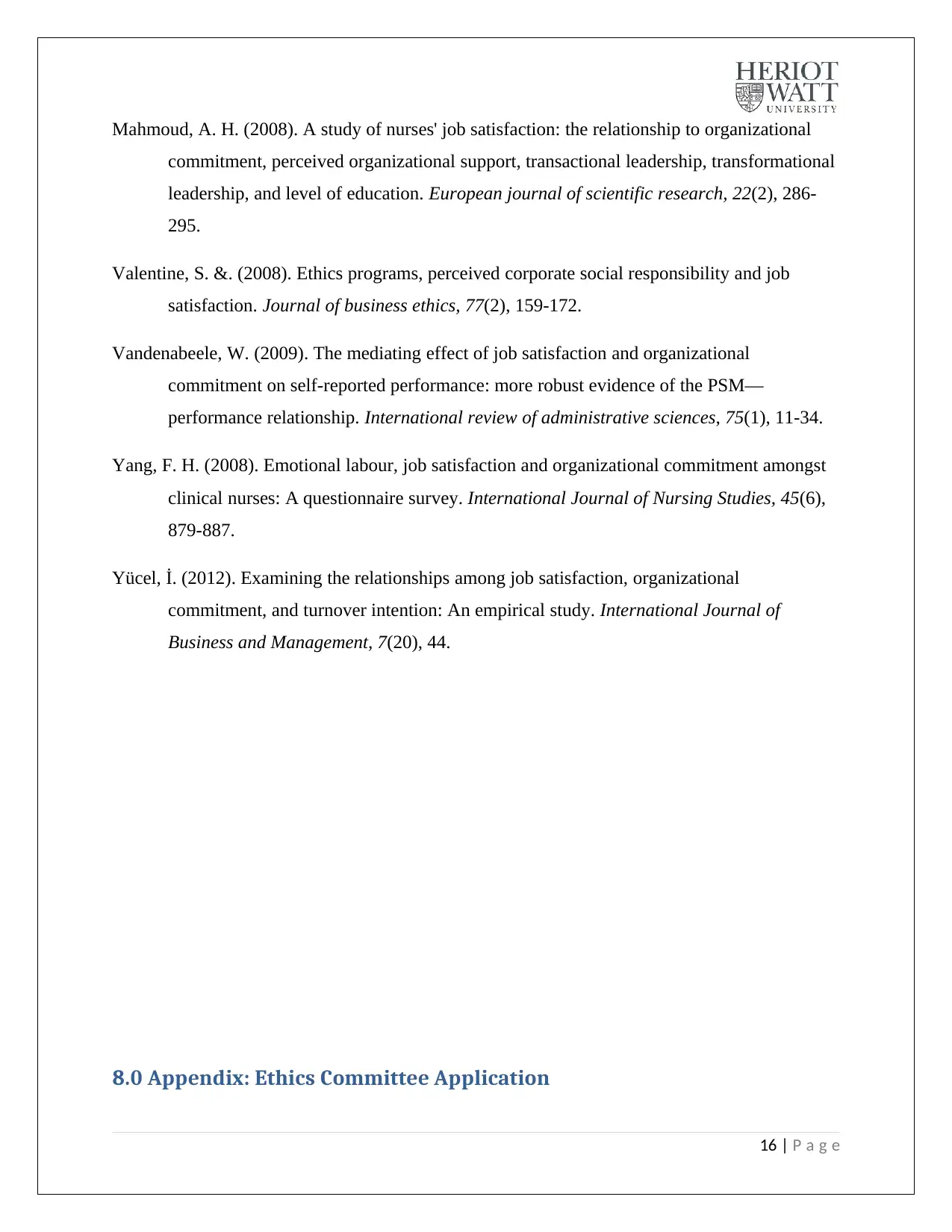
Mahmoud, A. H. (2008). A study of nurses' job satisfaction: the relationship to organizational
commitment, perceived organizational support, transactional leadership, transformational
leadership, and level of education. European journal of scientific research, 22(2), 286-
295.
Valentine, S. &. (2008). Ethics programs, perceived corporate social responsibility and job
satisfaction. Journal of business ethics, 77(2), 159-172.
Vandenabeele, W. (2009). The mediating effect of job satisfaction and organizational
commitment on self-reported performance: more robust evidence of the PSM—
performance relationship. International review of administrative sciences, 75(1), 11-34.
Yang, F. H. (2008). Emotional labour, job satisfaction and organizational commitment amongst
clinical nurses: A questionnaire survey. International Journal of Nursing Studies, 45(6),
879-887.
Yücel, İ. (2012). Examining the relationships among job satisfaction, organizational
commitment, and turnover intention: An empirical study. International Journal of
Business and Management, 7(20), 44.
8.0 Appendix: Ethics Committee Application
16 | P a g e
commitment, perceived organizational support, transactional leadership, transformational
leadership, and level of education. European journal of scientific research, 22(2), 286-
295.
Valentine, S. &. (2008). Ethics programs, perceived corporate social responsibility and job
satisfaction. Journal of business ethics, 77(2), 159-172.
Vandenabeele, W. (2009). The mediating effect of job satisfaction and organizational
commitment on self-reported performance: more robust evidence of the PSM—
performance relationship. International review of administrative sciences, 75(1), 11-34.
Yang, F. H. (2008). Emotional labour, job satisfaction and organizational commitment amongst
clinical nurses: A questionnaire survey. International Journal of Nursing Studies, 45(6),
879-887.
Yücel, İ. (2012). Examining the relationships among job satisfaction, organizational
commitment, and turnover intention: An empirical study. International Journal of
Business and Management, 7(20), 44.
8.0 Appendix: Ethics Committee Application
16 | P a g e
Secure Best Marks with AI Grader
Need help grading? Try our AI Grader for instant feedback on your assignments.
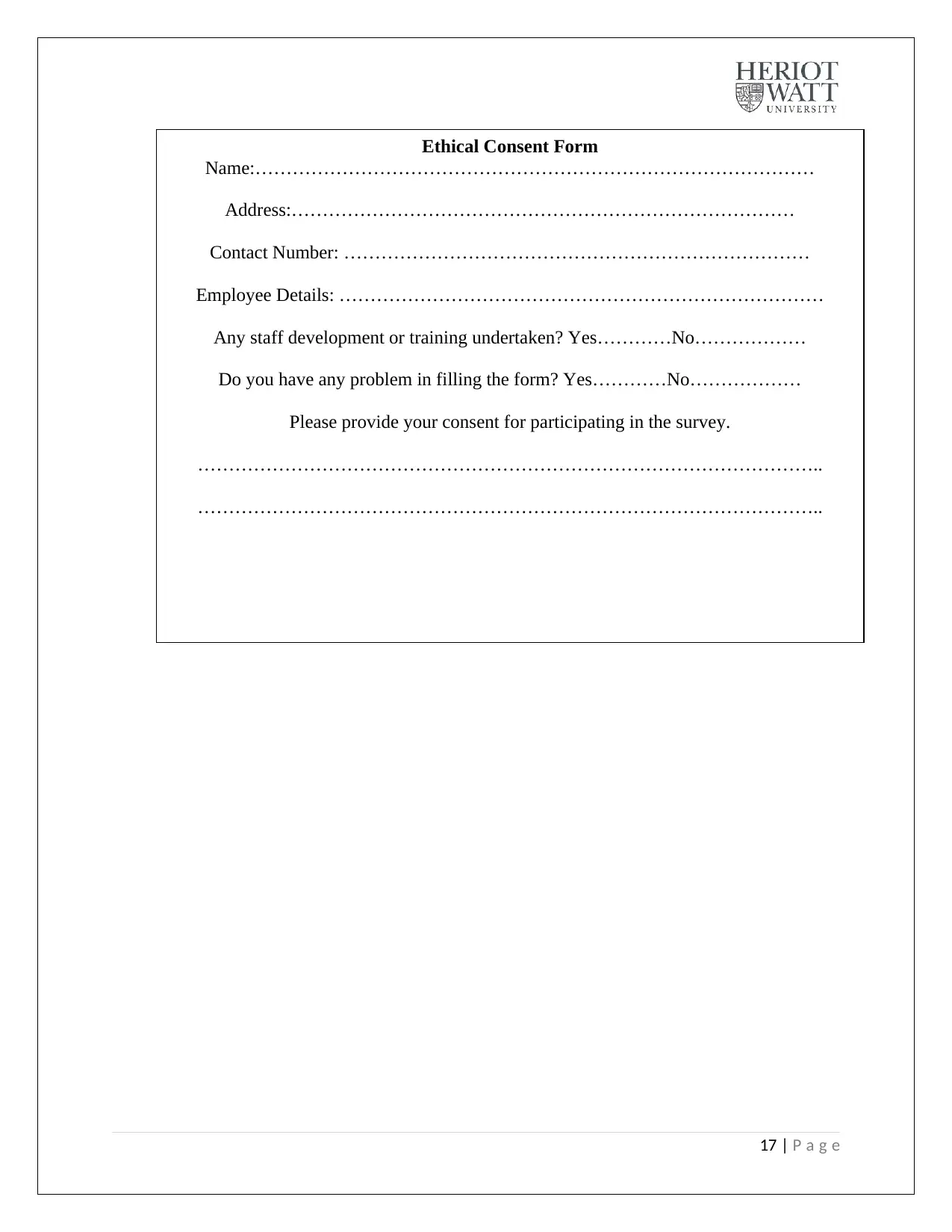
Ethical Consent Form
Name:………………………………………………………………………………
Address:………………………………………………………………………
Contact Number: …………………………………………………………………
Employee Details: ……………………………………………………………………
Any staff development or training undertaken? Yes…………No………………
Do you have any problem in filling the form? Yes…………No………………
Please provide your consent for participating in the survey.
………………………………………………………………………………………..
………………………………………………………………………………………..
17 | P a g e
Name:………………………………………………………………………………
Address:………………………………………………………………………
Contact Number: …………………………………………………………………
Employee Details: ……………………………………………………………………
Any staff development or training undertaken? Yes…………No………………
Do you have any problem in filling the form? Yes…………No………………
Please provide your consent for participating in the survey.
………………………………………………………………………………………..
………………………………………………………………………………………..
17 | P a g e
1 out of 17
Related Documents
Your All-in-One AI-Powered Toolkit for Academic Success.
+13062052269
info@desklib.com
Available 24*7 on WhatsApp / Email
![[object Object]](/_next/static/media/star-bottom.7253800d.svg)
Unlock your academic potential
© 2024 | Zucol Services PVT LTD | All rights reserved.




